You have no items in your cart. Want to get some nice things?
Go shopping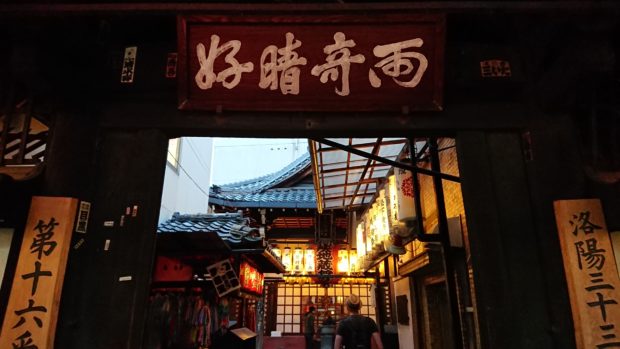
Start from part one of this series.
“Hope you see a geisha!” That was a recurring response to any mention of our forthcoming Japan honeymoon. Knowing how exclusive the world of a geisha is, my husband and I were under no illusions that we’d bump into one. But in old Kyoto, you got the impression one of these increasing rarities might round the corner at any second. A glimpse of that swallowtail bare nape might just outpace you, and vanish.
The first time we saw Gion was in the evening, during a light rain. And what a seductive show it put on. The pink sun diminished between buildings seemingly held together by telephone wires and neon bar signs. The lights from lanterns strung along Shijo Dori, the main road that crosses the river, doubled and tripled in puddles, on cars, their diffused glow giving the sensation of a haunted present.
I became aware of romanticising my surroundings. When I spotted a young woman in a pretty kimono, my heart almost burst. But she wasn’t a geisha. Aside from the absence of the distinctive makeup, she had that uncertain air of a tourist. Not to mention her boyfriend was super-trendy. We noticed many more of her, most of them Chinese-speaking, as we walked in our daze through the city, along with many shops advertising geisha-lite costume hire. For a few yen you could be the outline of the painting.
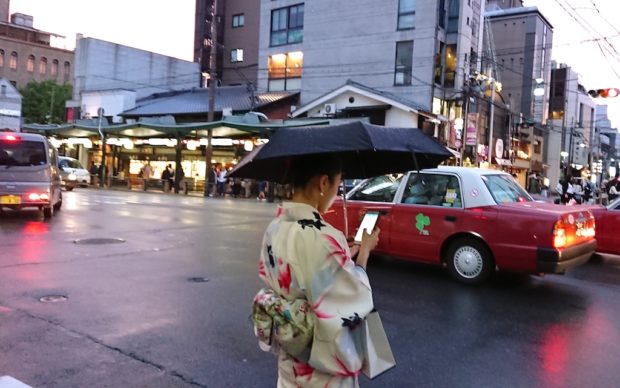
Up until then, I’d already been imagining myself living in Kyoto. But would it be the city that proved the most touristy? Was I one of the suckers falling for the promise of an authentic experience that was anything but?
It didn’t bother me. Gion was drenched in atmosphere, regardless of how many people laden with boutique shopping bags took selfies in it. Traditional bars and restaurants crowded together on and off a thoroughfare, lit by coloured vinyl lanterns. Bamboo shutters, tiled roofs and wooden doors hid secrets in their shadows.
Through the rain slithering over my clear plastic umbrella I made out the grand building at Gion Corner, where we decided to watch a summary of Japanese cultural highlights. The show led us through such hallmarks as kabuki theatre, a geisha dance, puppet show and tea ceremony. Though we didn’t understand a word, the humour, artistry and/or poise shone through each segment. We had no yardstick to measure against, but even this tourist attraction appeared to be handled with due reverence by the ensemble. The worst part of the evening was, in fact, the audience, most of whom talked throughout as if they were on Gogglebox. I’ll never forget the shame and frustration I felt, added to my usual misanthropy.
At least I was still able to admire what was going on on the stage: a woman with a barely lined, handsome face, conducting a tea ceremony; her every movement perfectly controlled, honed over decades. We didn’t deserve her politeness.
*
Being vegetarian, I must be annoying to travel with. During our week in Norway, I contentedly nibbled at rye bread and brown cheese while my husband spent the trip scavenging for reindeer neck. We concluded the alleged delicacy must be a myth, like the popularity of jellied eels in London post-1939.
Armed with the Happy Cow app, I found it easy to locate veggie-friendly establishments in Kyoto. Even the broken little Japanese I used to explain my gastronomic persuasion was enough for the waiting staff to deliver food free of meat, fish, gelatine, and the dreaded dashi – a stock made of kelp and fermented tuna that’s omnipresent in Japanese cuisine. The reason for such widespread, deep understanding of the vegetarian diet in Kyoto is simple: temples. With so many monks around, the locals are accustomed to tailoring their menus. Considering almost every Japanese folktale is a cautionary parable about how fishing in a nearby stream might lead to your entire family’s demise, it might be surprising that the majority of locals are happy to risk their lives with wanton lashings of cod and hog.
There were times, I admit, when I had no idea what I was eating. When scanning lists of ingredients, my phone’s camera threw up translations such as “wind boy” and “boot without relish”. Assuming no child had been mashed into a sweetmeat, I took my chances. I started bravely, with mochi balls I picked up from a train station. These sweets look gelatinous, but are in fact vegan. Made of pounded sticky rice and bean paste, mochi texture is elastic and gummy. Sticking with the Japanese motif of onomatopoeia, the name evokes what it sounds and feels like to eat one. The ones we bought contained whole strawberries and mandarins within them, a burst of freshness in the mouth I welcomed as we sat in the sun outside Nijō Castle.
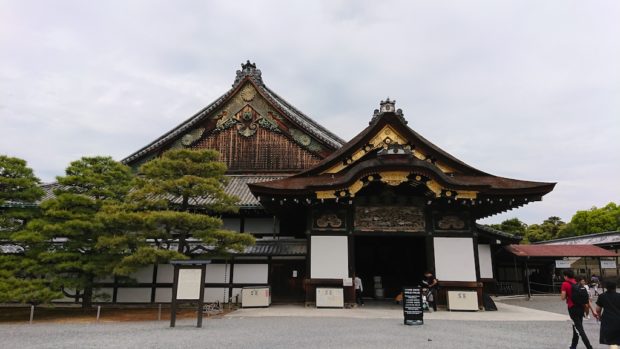
We then entered the castle walls to find the ground littered with schoolchildren. Thankfully, they simply stood diligently in the forecourt, sailor-chic uniforms spotless, and conducted themselves with the courtesy and respect that was evident throughout our Japan travels so far. If we’d been in England, those children would have been swinging from gargoyles or exhuming corpses. I never felt more Daily Mail than when I found myself smiling at the behaviour of Japanese youths.
Having been instructed to remove our shoes, we padded the wooden “nightingale” floors of Nijō Castle in our socks, setting off with every movement the chirping sounds that gave them their nickname. According to signs along the circuitous route, this noise had not been intentional in the building’s design, but was in fact an accident arising from nails rubbing against clamps. Either way, it made an excellent security system, alerting anyone in the castle to movement within. As in all the traditional wooden buildings of Japan, there was an atmosphere of solemn calm here. The corridor rounded a cluster of large square rooms, conducive to contemplation. I was entranced for minutes by a scene depicting several rows of traditionally-attired male mannequins bowing on their knees before their master, who was sitting cross-legged on a slightly raised platform. Painted Japanese pines adorned the sliding walls, but almost all the structural detail was in the ceiling; as if to infer domination from above.
As we weren’t allowed to step inside these rooms, an annexed museum offered us the chance to experience sitting within them. We lowered ourselves onto tatami mats and gazed at painted scenes of lions that didn’t look quite like lions – because how would an artist in feudal Japan have seen one in person?
From the floor of the café in the large grounds, we admired the manicured garden. I ate matcha chiffon cake while I watched my husband tackle making his own matcha tea with the equipment and instructions provided. That was the moment it really sank in for me – that we were on our honeymoon. This person sitting opposite me, the sunlight striking his blue-green English eyes, was my husband. That he was so eager to see the world, to gush over new sights and learn about other cultures, to experience Japan in the same way he was so willing to explore my own homeland, even to attempt to learn my language, only made me love him more.
*
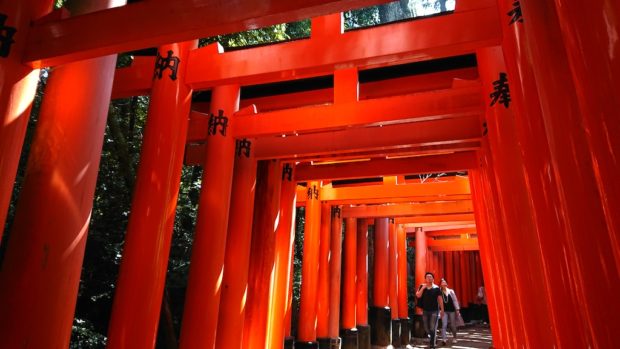
By stepping through the immense vermilion gate, we had entered a sacred place. But so had thousands of others. I waited while groups of teenagers took their selfies so that I could frame my shot of the Fushimi Inari shrine’s entrance. A gang of faux-geishas in hired kimonos struck a pose for their friend’s Instagram account, so I went along with it and snapped that. Along with train station stamps and hundreds of photos on our phones, my husband and I documented our honeymoon with far less frequent Instax mini shots. We had three rolls of film, thirty photos, so I had to be selective. In Kyoto, I decided that instead of waiting for tourists to clear out of the way, I would simply include them in my photographic journey. After all, they were as much a part of the place now, at this time, as the myriad sculptures of foxes and me.
Like many in Kyoto, this grand shrine, built at the base of a mountain and spreading its sacred gates and tombs up it like a creeper, is dedicated to Inari, Shinto god of rice. Foxes (kitsune) were thought to be his messengers, so you can’t walk a few metres without encountering a stone effigy of one, or a couple, or a group of ten, on ledges and plinths.
The crowds carried us towards the main attraction here: two rows of densely packed torii gates, a tall π shape, going on for a seeming vermilion eternity. As I walked through this unusual tunnel, the brightness of the colour against the lush wooded mountain and the sunlight running along the gaps like fingers, I overheard a conversation between a group of North Americans. One of them was a young stud born to Japanese migrants. His take on the place: “It’s kind of repetitive. Just the same thing over and over.” There I was being hypnotised into a trance while someone with an actual connection to this land was bored out of his wits. I wondered if he was taking it for granted, and if I did the same with my motherland of Cyprus, or if maybe he was right and I was just easily charmed. An Occidental searching for his soul.
On the backs of the gates were Japanese symbols. I looked up what the writing might mean, expecting wise and quotable statements, when I discovered it was actually branding. The gorgeous calligraphy spelled out names of businesses or donors who had erected a gate in their name. Though this might sound cynical, a corporate approach to shrine-building, there’s a kernel of beauty in the practice; people donate torii as a mark of gratitude for their success.
My husband and I carried on up the path of torii, letting the majority of other tourists fade away. We reached a village of shrines covered in kitsune sculptures, on the edge of a broad green forest lake. I wondered why I lacked faith, and the need of it. This was a soothing place, its effect physical. I felt it in my breath, my bones.
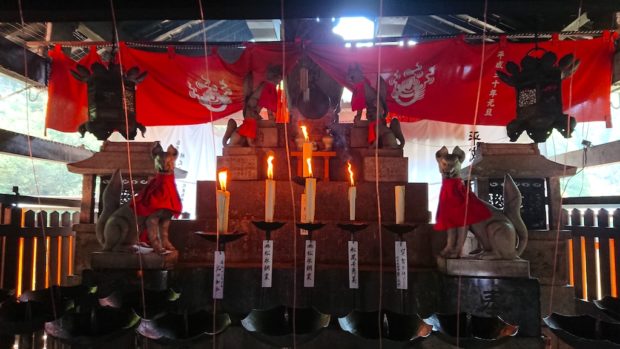
About an hour later, we had travelled back down the slope, off the vermilion trail. We arrived at the thousand-year-old shrine at the base of the mountain, itself an impressively ornate structure of painted wood, to the sound of music. Nearby, three young women in ceremonial dress were communing with, or channelling, the gods. There was the steady beat of a drum, its authority loudly proclaimed. Over that glided the sound of a bamboo flute, mingling with the high-pitched melody of a human – almost transhuman – voice. The sound was nothing short of beguiling.
A security guard stood at the front to keep the tourists at bay, and watched with eagle eyes for anyone trying to capture the performance. He was the barrier keeping this other world apart from ours.
*
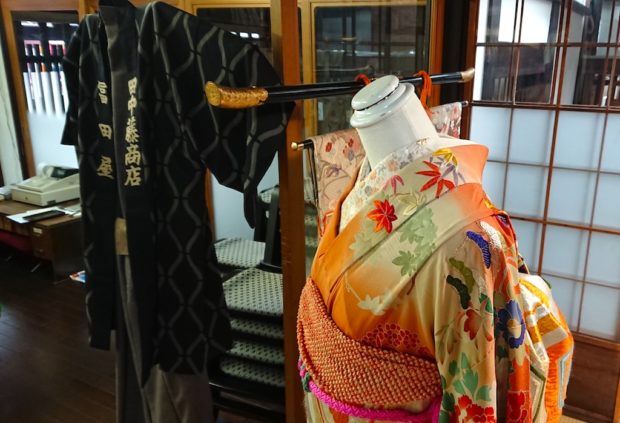
Though we’d seen our fair share of shrines and temples in Kyoto by now, my husband was eager to splash some of our money on another traditional activity: a tea ceremony. I was reluctant, partly due to funds and partly due to not wanting to feel like a tourist. I couldn’t seem to get it in my head that that’s exactly what I was – and, according to Japan-dwelling friends, would be regarded as such even if I’d lived there for years.
We found our way through the older neighbourhoods to Tondaya, one of Kyoto’s oldest and finest kimono workshops. At 130 years old, the townhouse had a modest entrance hall (including a well) which opened out to an almost linear sequence of rooms. The workshop, with its rolls of fabric on long black surfaces, was marked by a silk-draped mannequin at its entrance. A reception room, where guests partaking in the tea ceremony are invited to don kimonos, sported beautiful antique wooden dressers, as well as views to enclosed gardens. There were shrines both Shinto and Buddhist, decorated especially for the forthcoming celebration of Children’s Day.
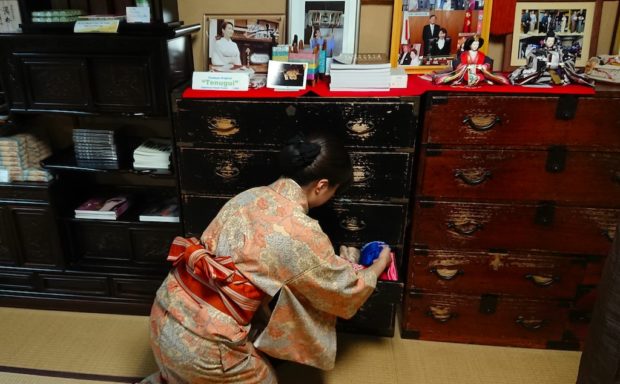
Our host, a young woman in a silk kimono who was an undergrad at the university, answered all our questions with a smile as she guided us through the house. She showed us another reception room, further back from one of the interior gardens and through another wood-floored corridor, where guests of the past would be treated to Noh performances by the owners. Our host explained that the current owners were the thirteenth generation of this particular family of kimono makers. Back in the first reception room, she had pointed out that the stunning long-sleeved silk piece draped over a wooden stand was the wedding kimono of the tenth owner’s bride, which is just the sort of thing to make my skeleton judder in fits of pleasure.
She then showed us into the small room set up for the tea ceremony. Presumably because they were catering for tourists unused to lowering and raising themselves while wearing kimono, the owners had provided benches for us to sit on.
Our host explained each step of the ceremony to us before she began. Then we watched her perform it in silence. As someone who’s internally jumbled, I am awed by perfect control. Every motion in a tea ceremony is conducted with the utmost precision. The whisking of green powder in a bowl; the folding of a napkin; the lifting of a lid, a spoon; the presentation of the ready cup which you, upon receiving, must turn three times in your palm so as to admire its design, then raise it to your mouth, and imbibe the green froth in up to three sips.
Afterwards, we bowed our thanks. Our host offered to take photographs of us in our kimonos, which perfectly captured my awkwardness. You could almost see the words “cultural appropriation” in my eyes. But if she was bothered by this, our hostess didn’t show it. She gave us swords to use as props for our picture, and smiled delightedly as she snapped away on our phones. Having removed our kimonos, I watched as our traditional experience was neatly folded away, placed in that huge wooden dresser that had served so many generations of this home’s family.
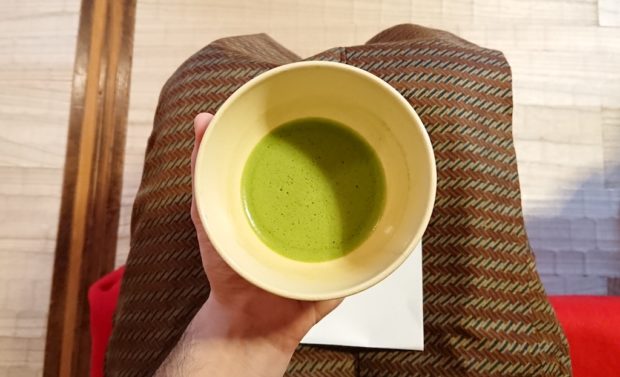
*
I don’t remember why I was upset. Something had got to me and put me in a mood. I remember sitting in silence with my husband on the riverbank, at the wooden feet of the lantern-lit restaurants, where we watched a heron in the water. Maybe I was annoyed that he’d decided our schedule by vetoing one of my suggestions. Or rather, maybe I was annoyed because he was invariably right when it came to planning anything. I remember thinking, as before, This is my husband. This is our honeymoon. What if he hates me by the end of it?
This was the longest we’d ever be spending on our own together, with none of our daily comforts; routine, which I despise anyway; friends; familiar surroundings; a language we could speak and understand.
Maybe I just didn’t want to leave Kyoto. We returned to Gion, to soak it up before we were due to leave. We walked up hilly streets where hostesses beckoned us into restaurants. I hobbled along, afflicted by blisters on my feet that had only mushroomed since our hike in Kiso Valley. How do you say “blister pads” in Japanese? I was too scared to try, what with my translation failures regarding food.
We browsed a quirky shop of antiques and collectables, some of them nostalgic for a Japan we never knew and some inventively pornographic in ways no-one could know.
As we made our way back to the bridge, towards dinner somewhere, I remembered I hadn’t taken any photos of Gion on my Instax camera. What a romantic hipster I was, longing to capture this place, this mood, in Polaroid aesthetic. I realised that in my scouting for a good location to frame a picture, I was lagging far behind my husband, who was just about to turn a corner. I hadn’t even taken my backpack off my shoulders to retrieve my film camera when something walked towards me. It was a sight I’d never, in all my romantic daydreaming, hoped to see: a geisha.
This was no phoney. No tourist in a hired kimono. Her very air marked her out as a unicorn. Walking quickly, head high, white face and painted lips, she was evading the gathering gawking crowds as she made her way to a private appointment. Her face, her hair, the decoration on both, approached me as I fumbled for my phone to take a picture. A bad shot. I watched her depart.
“Oh my God!” my husband exclaimed, running towards me. “Wasn’t she so pretty?”
And he excitedly showed me the photo he’d taken, after having turned the corner to find her there. It was a picture of the geisha hurrying away, in the dying sunlight of old Gion. The swallowtail of bare nape served as a reminder: what we’d just witnessed was the real deal.
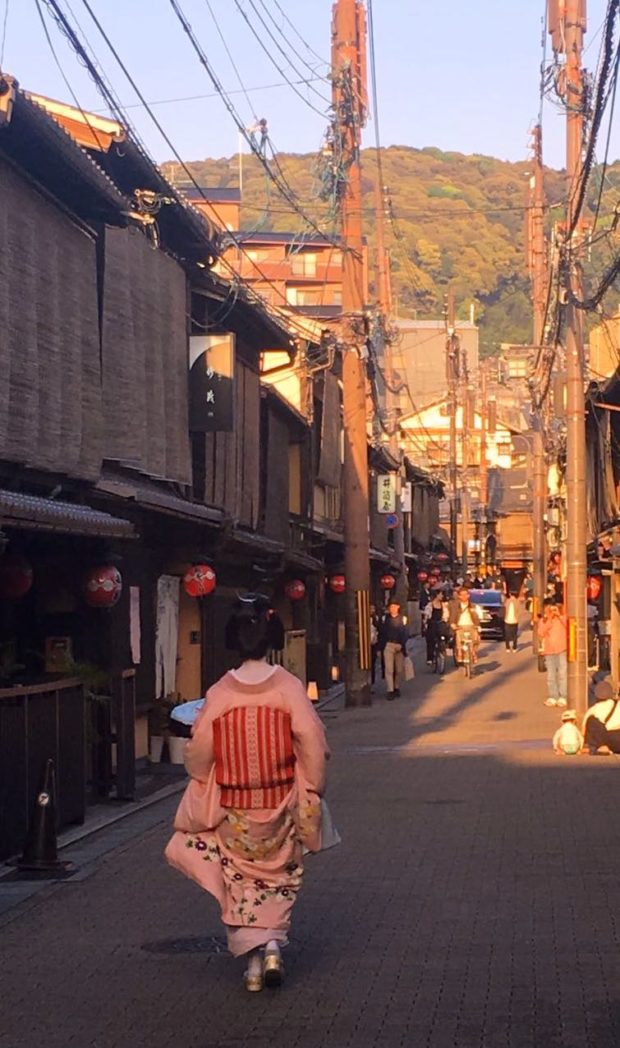
To be continued.
Polis Loizou’s debut novel, Disbanded Kingdom, is out now.

About Polis Loizou
Polis Loizou is a co-founder of The Off-Off-Off-Broadway Company, which primarily performs his plays, and has had a series of successes since their first hit at the Buxton Fringe in 2009. His short stories have been featured in The Stockholm Review of Literature and Liars’ League NYC, and he is a frequent contributor to Litro Magazine. Born and raised in Cyprus, Polis is currently based in Nottingham after 14 years in London. 'Disbanded Kingdom' is his first published novel. He is currently represented by Litro's bespoke literary agency, Litro Represents.
- Web |
- More Posts(25)



